NUR250: Comprehensive Case Study: Peter Newman and COPD Management
VerifiedAdded on 2023/01/17
|12
|3418
|95
Case Study
AI Summary
This case study focuses on Peter Newman, a 44-year-old man diagnosed with Chronic Obstructive Pulmonary Disease (COPD) and admitted to the healthcare center due to breathlessness. The assignment requires the application of the clinical reasoning cycle to assess Peter's condition, identify risk factors like smoking and occupational exposures, and determine nursing priorities. The assessment includes measuring respiration rate, spirometry tests, and arterial blood gas measurements. The care plan involves interventions for airway clearance (medications, coughing techniques), improving breathing patterns (diaphragmatic breathing, oxygen therapy), and enhancing activity tolerance. The evaluation includes monitoring vital signs and assessing the patient's response to treatments and overall quality of life. This case study provides a detailed analysis of COPD management, including assessment, planning, implementation, and evaluation of nursing care.

Running head: CASE STUDY OF PETER NEWMAN
CASE STUDY OF PETER NEWMAN
Name of the student:
Name of the university:
Author note:
CASE STUDY OF PETER NEWMAN
Name of the student:
Name of the university:
Author note:
Paraphrase This Document
Need a fresh take? Get an instant paraphrase of this document with our AI Paraphraser
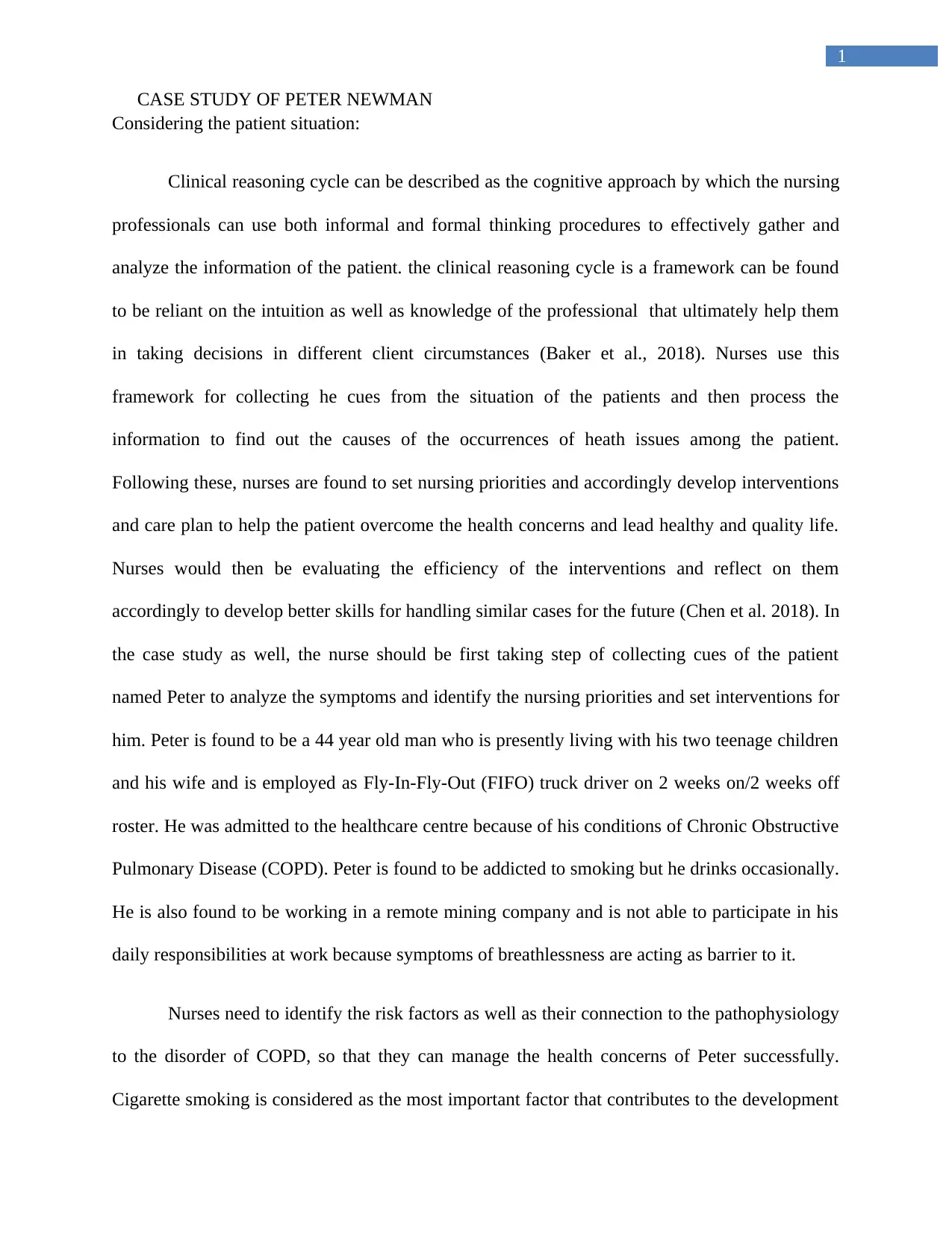
1
CASE STUDY OF PETER NEWMAN
Considering the patient situation:
Clinical reasoning cycle can be described as the cognitive approach by which the nursing
professionals can use both informal and formal thinking procedures to effectively gather and
analyze the information of the patient. the clinical reasoning cycle is a framework can be found
to be reliant on the intuition as well as knowledge of the professional that ultimately help them
in taking decisions in different client circumstances (Baker et al., 2018). Nurses use this
framework for collecting he cues from the situation of the patients and then process the
information to find out the causes of the occurrences of heath issues among the patient.
Following these, nurses are found to set nursing priorities and accordingly develop interventions
and care plan to help the patient overcome the health concerns and lead healthy and quality life.
Nurses would then be evaluating the efficiency of the interventions and reflect on them
accordingly to develop better skills for handling similar cases for the future (Chen et al. 2018). In
the case study as well, the nurse should be first taking step of collecting cues of the patient
named Peter to analyze the symptoms and identify the nursing priorities and set interventions for
him. Peter is found to be a 44 year old man who is presently living with his two teenage children
and his wife and is employed as Fly-In-Fly-Out (FIFO) truck driver on 2 weeks on/2 weeks off
roster. He was admitted to the healthcare centre because of his conditions of Chronic Obstructive
Pulmonary Disease (COPD). Peter is found to be addicted to smoking but he drinks occasionally.
He is also found to be working in a remote mining company and is not able to participate in his
daily responsibilities at work because symptoms of breathlessness are acting as barrier to it.
Nurses need to identify the risk factors as well as their connection to the pathophysiology
to the disorder of COPD, so that they can manage the health concerns of Peter successfully.
Cigarette smoking is considered as the most important factor that contributes to the development
CASE STUDY OF PETER NEWMAN
Considering the patient situation:
Clinical reasoning cycle can be described as the cognitive approach by which the nursing
professionals can use both informal and formal thinking procedures to effectively gather and
analyze the information of the patient. the clinical reasoning cycle is a framework can be found
to be reliant on the intuition as well as knowledge of the professional that ultimately help them
in taking decisions in different client circumstances (Baker et al., 2018). Nurses use this
framework for collecting he cues from the situation of the patients and then process the
information to find out the causes of the occurrences of heath issues among the patient.
Following these, nurses are found to set nursing priorities and accordingly develop interventions
and care plan to help the patient overcome the health concerns and lead healthy and quality life.
Nurses would then be evaluating the efficiency of the interventions and reflect on them
accordingly to develop better skills for handling similar cases for the future (Chen et al. 2018). In
the case study as well, the nurse should be first taking step of collecting cues of the patient
named Peter to analyze the symptoms and identify the nursing priorities and set interventions for
him. Peter is found to be a 44 year old man who is presently living with his two teenage children
and his wife and is employed as Fly-In-Fly-Out (FIFO) truck driver on 2 weeks on/2 weeks off
roster. He was admitted to the healthcare centre because of his conditions of Chronic Obstructive
Pulmonary Disease (COPD). Peter is found to be addicted to smoking but he drinks occasionally.
He is also found to be working in a remote mining company and is not able to participate in his
daily responsibilities at work because symptoms of breathlessness are acting as barrier to it.
Nurses need to identify the risk factors as well as their connection to the pathophysiology
to the disorder of COPD, so that they can manage the health concerns of Peter successfully.
Cigarette smoking is considered as the most important factor that contributes to the development
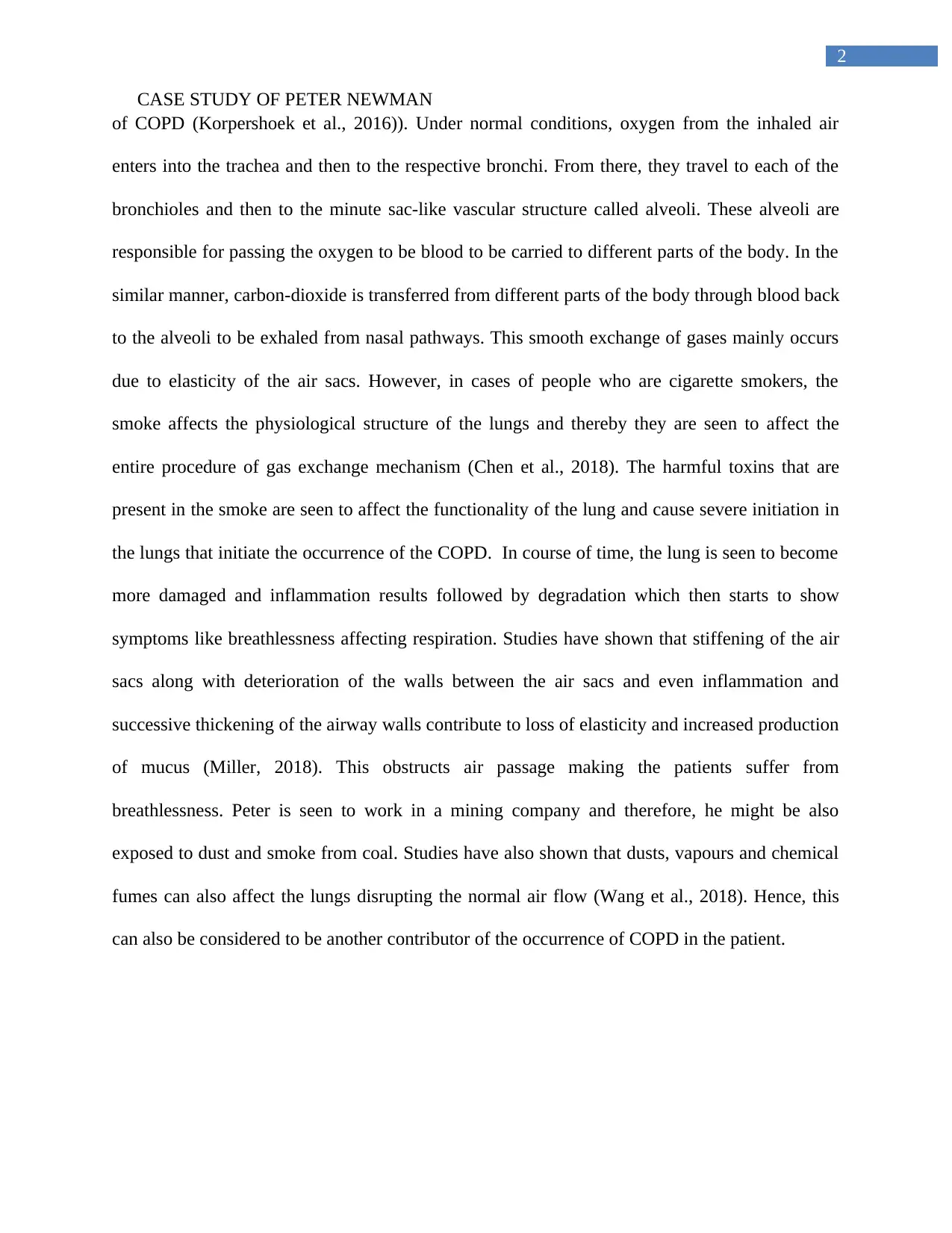
2
CASE STUDY OF PETER NEWMAN
of COPD (Korpershoek et al., 2016)). Under normal conditions, oxygen from the inhaled air
enters into the trachea and then to the respective bronchi. From there, they travel to each of the
bronchioles and then to the minute sac-like vascular structure called alveoli. These alveoli are
responsible for passing the oxygen to be blood to be carried to different parts of the body. In the
similar manner, carbon-dioxide is transferred from different parts of the body through blood back
to the alveoli to be exhaled from nasal pathways. This smooth exchange of gases mainly occurs
due to elasticity of the air sacs. However, in cases of people who are cigarette smokers, the
smoke affects the physiological structure of the lungs and thereby they are seen to affect the
entire procedure of gas exchange mechanism (Chen et al., 2018). The harmful toxins that are
present in the smoke are seen to affect the functionality of the lung and cause severe initiation in
the lungs that initiate the occurrence of the COPD. In course of time, the lung is seen to become
more damaged and inflammation results followed by degradation which then starts to show
symptoms like breathlessness affecting respiration. Studies have shown that stiffening of the air
sacs along with deterioration of the walls between the air sacs and even inflammation and
successive thickening of the airway walls contribute to loss of elasticity and increased production
of mucus (Miller, 2018). This obstructs air passage making the patients suffer from
breathlessness. Peter is seen to work in a mining company and therefore, he might be also
exposed to dust and smoke from coal. Studies have also shown that dusts, vapours and chemical
fumes can also affect the lungs disrupting the normal air flow (Wang et al., 2018). Hence, this
can also be considered to be another contributor of the occurrence of COPD in the patient.
CASE STUDY OF PETER NEWMAN
of COPD (Korpershoek et al., 2016)). Under normal conditions, oxygen from the inhaled air
enters into the trachea and then to the respective bronchi. From there, they travel to each of the
bronchioles and then to the minute sac-like vascular structure called alveoli. These alveoli are
responsible for passing the oxygen to be blood to be carried to different parts of the body. In the
similar manner, carbon-dioxide is transferred from different parts of the body through blood back
to the alveoli to be exhaled from nasal pathways. This smooth exchange of gases mainly occurs
due to elasticity of the air sacs. However, in cases of people who are cigarette smokers, the
smoke affects the physiological structure of the lungs and thereby they are seen to affect the
entire procedure of gas exchange mechanism (Chen et al., 2018). The harmful toxins that are
present in the smoke are seen to affect the functionality of the lung and cause severe initiation in
the lungs that initiate the occurrence of the COPD. In course of time, the lung is seen to become
more damaged and inflammation results followed by degradation which then starts to show
symptoms like breathlessness affecting respiration. Studies have shown that stiffening of the air
sacs along with deterioration of the walls between the air sacs and even inflammation and
successive thickening of the airway walls contribute to loss of elasticity and increased production
of mucus (Miller, 2018). This obstructs air passage making the patients suffer from
breathlessness. Peter is seen to work in a mining company and therefore, he might be also
exposed to dust and smoke from coal. Studies have also shown that dusts, vapours and chemical
fumes can also affect the lungs disrupting the normal air flow (Wang et al., 2018). Hence, this
can also be considered to be another contributor of the occurrence of COPD in the patient.
⊘ This is a preview!⊘
Do you want full access?
Subscribe today to unlock all pages.

Trusted by 1+ million students worldwide
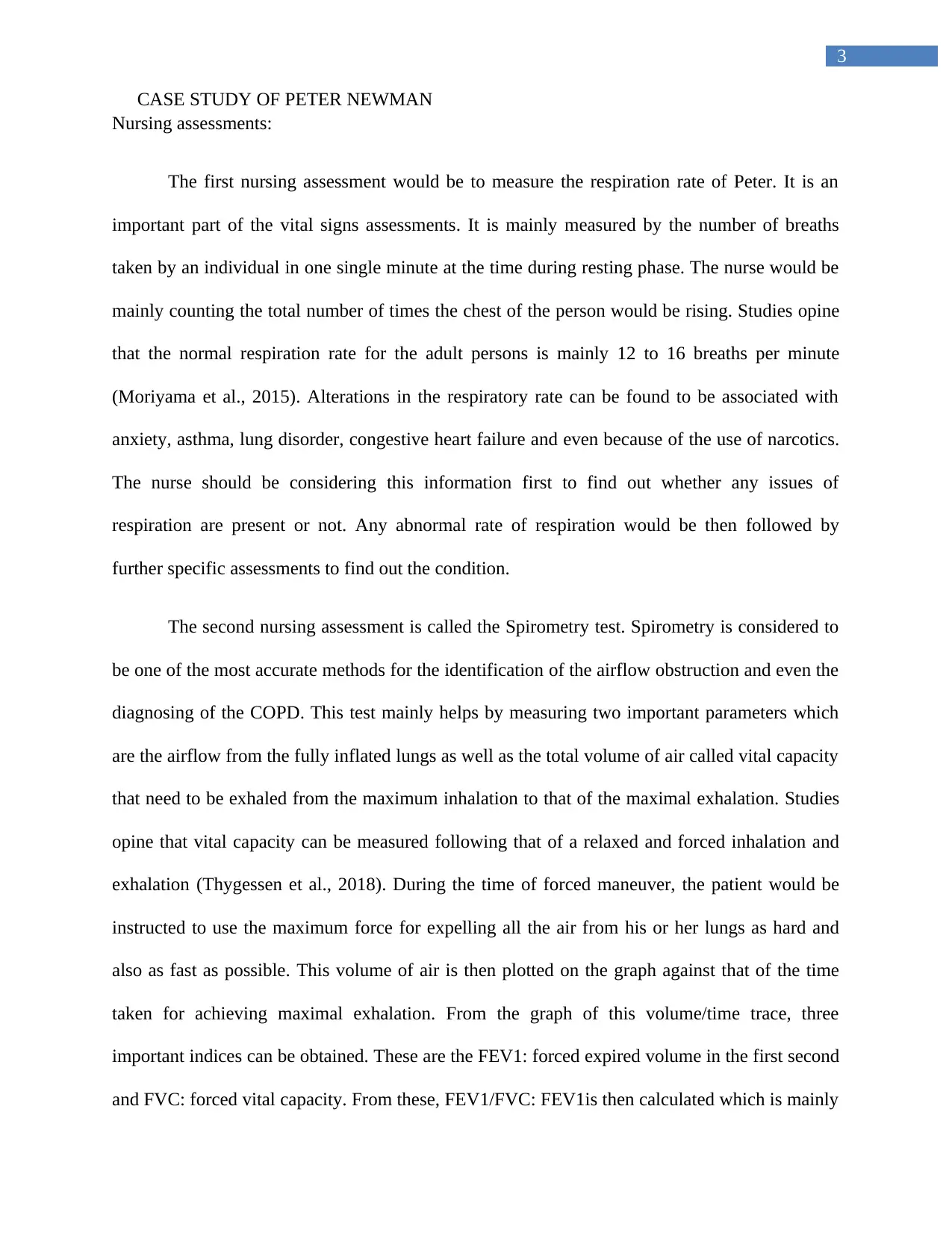
3
CASE STUDY OF PETER NEWMAN
Nursing assessments:
The first nursing assessment would be to measure the respiration rate of Peter. It is an
important part of the vital signs assessments. It is mainly measured by the number of breaths
taken by an individual in one single minute at the time during resting phase. The nurse would be
mainly counting the total number of times the chest of the person would be rising. Studies opine
that the normal respiration rate for the adult persons is mainly 12 to 16 breaths per minute
(Moriyama et al., 2015). Alterations in the respiratory rate can be found to be associated with
anxiety, asthma, lung disorder, congestive heart failure and even because of the use of narcotics.
The nurse should be considering this information first to find out whether any issues of
respiration are present or not. Any abnormal rate of respiration would be then followed by
further specific assessments to find out the condition.
The second nursing assessment is called the Spirometry test. Spirometry is considered to
be one of the most accurate methods for the identification of the airflow obstruction and even the
diagnosing of the COPD. This test mainly helps by measuring two important parameters which
are the airflow from the fully inflated lungs as well as the total volume of air called vital capacity
that need to be exhaled from the maximum inhalation to that of the maximal exhalation. Studies
opine that vital capacity can be measured following that of a relaxed and forced inhalation and
exhalation (Thygessen et al., 2018). During the time of forced maneuver, the patient would be
instructed to use the maximum force for expelling all the air from his or her lungs as hard and
also as fast as possible. This volume of air is then plotted on the graph against that of the time
taken for achieving maximal exhalation. From the graph of this volume/time trace, three
important indices can be obtained. These are the FEV1: forced expired volume in the first second
and FVC: forced vital capacity. From these, FEV1/FVC: FEV1is then calculated which is mainly
CASE STUDY OF PETER NEWMAN
Nursing assessments:
The first nursing assessment would be to measure the respiration rate of Peter. It is an
important part of the vital signs assessments. It is mainly measured by the number of breaths
taken by an individual in one single minute at the time during resting phase. The nurse would be
mainly counting the total number of times the chest of the person would be rising. Studies opine
that the normal respiration rate for the adult persons is mainly 12 to 16 breaths per minute
(Moriyama et al., 2015). Alterations in the respiratory rate can be found to be associated with
anxiety, asthma, lung disorder, congestive heart failure and even because of the use of narcotics.
The nurse should be considering this information first to find out whether any issues of
respiration are present or not. Any abnormal rate of respiration would be then followed by
further specific assessments to find out the condition.
The second nursing assessment is called the Spirometry test. Spirometry is considered to
be one of the most accurate methods for the identification of the airflow obstruction and even the
diagnosing of the COPD. This test mainly helps by measuring two important parameters which
are the airflow from the fully inflated lungs as well as the total volume of air called vital capacity
that need to be exhaled from the maximum inhalation to that of the maximal exhalation. Studies
opine that vital capacity can be measured following that of a relaxed and forced inhalation and
exhalation (Thygessen et al., 2018). During the time of forced maneuver, the patient would be
instructed to use the maximum force for expelling all the air from his or her lungs as hard and
also as fast as possible. This volume of air is then plotted on the graph against that of the time
taken for achieving maximal exhalation. From the graph of this volume/time trace, three
important indices can be obtained. These are the FEV1: forced expired volume in the first second
and FVC: forced vital capacity. From these, FEV1/FVC: FEV1is then calculated which is mainly
Paraphrase This Document
Need a fresh take? Get an instant paraphrase of this document with our AI Paraphraser
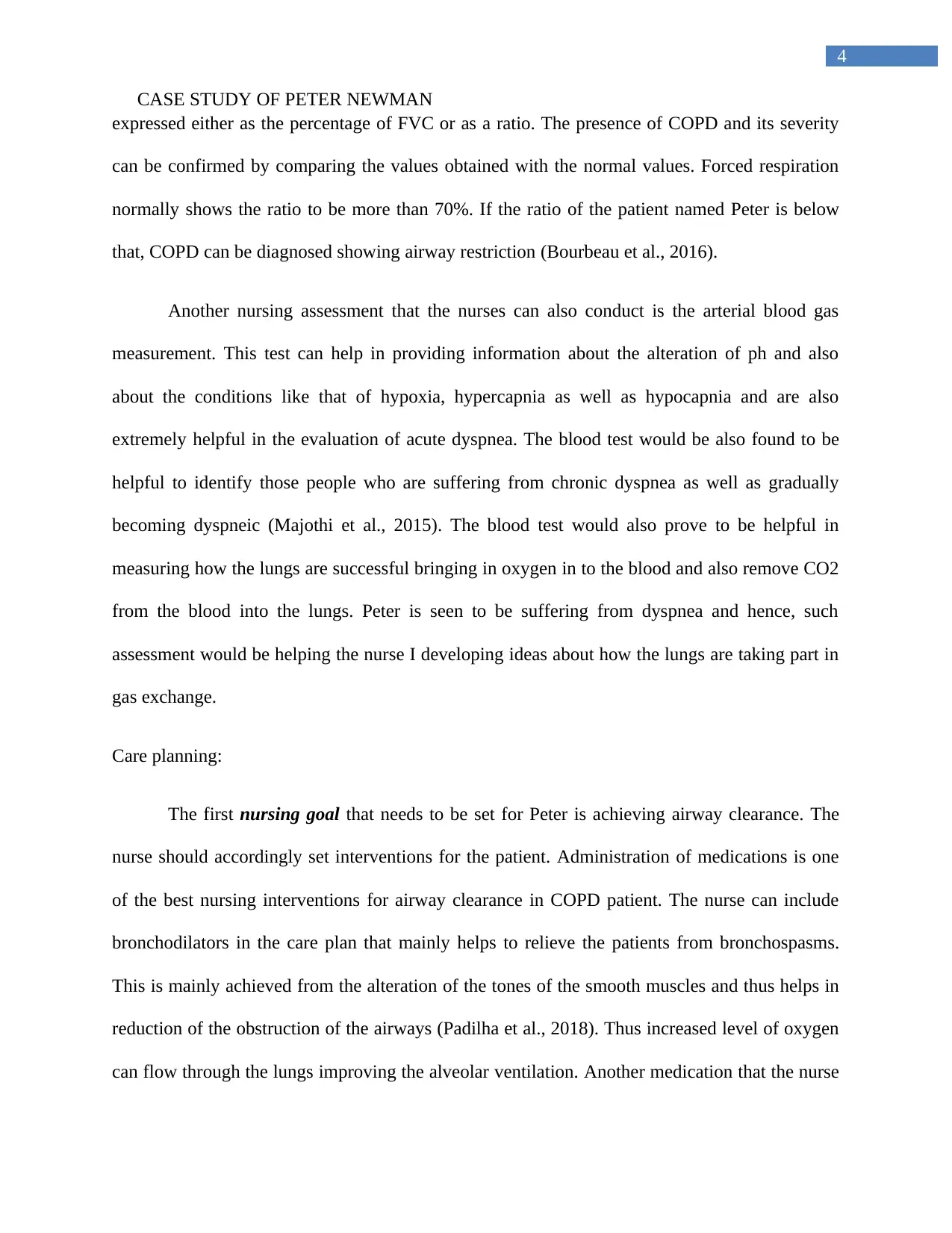
4
CASE STUDY OF PETER NEWMAN
expressed either as the percentage of FVC or as a ratio. The presence of COPD and its severity
can be confirmed by comparing the values obtained with the normal values. Forced respiration
normally shows the ratio to be more than 70%. If the ratio of the patient named Peter is below
that, COPD can be diagnosed showing airway restriction (Bourbeau et al., 2016).
Another nursing assessment that the nurses can also conduct is the arterial blood gas
measurement. This test can help in providing information about the alteration of ph and also
about the conditions like that of hypoxia, hypercapnia as well as hypocapnia and are also
extremely helpful in the evaluation of acute dyspnea. The blood test would be also found to be
helpful to identify those people who are suffering from chronic dyspnea as well as gradually
becoming dyspneic (Majothi et al., 2015). The blood test would also prove to be helpful in
measuring how the lungs are successful bringing in oxygen in to the blood and also remove CO2
from the blood into the lungs. Peter is seen to be suffering from dyspnea and hence, such
assessment would be helping the nurse I developing ideas about how the lungs are taking part in
gas exchange.
Care planning:
The first nursing goal that needs to be set for Peter is achieving airway clearance. The
nurse should accordingly set interventions for the patient. Administration of medications is one
of the best nursing interventions for airway clearance in COPD patient. The nurse can include
bronchodilators in the care plan that mainly helps to relieve the patients from bronchospasms.
This is mainly achieved from the alteration of the tones of the smooth muscles and thus helps in
reduction of the obstruction of the airways (Padilha et al., 2018). Thus increased level of oxygen
can flow through the lungs improving the alveolar ventilation. Another medication that the nurse
CASE STUDY OF PETER NEWMAN
expressed either as the percentage of FVC or as a ratio. The presence of COPD and its severity
can be confirmed by comparing the values obtained with the normal values. Forced respiration
normally shows the ratio to be more than 70%. If the ratio of the patient named Peter is below
that, COPD can be diagnosed showing airway restriction (Bourbeau et al., 2016).
Another nursing assessment that the nurses can also conduct is the arterial blood gas
measurement. This test can help in providing information about the alteration of ph and also
about the conditions like that of hypoxia, hypercapnia as well as hypocapnia and are also
extremely helpful in the evaluation of acute dyspnea. The blood test would be also found to be
helpful to identify those people who are suffering from chronic dyspnea as well as gradually
becoming dyspneic (Majothi et al., 2015). The blood test would also prove to be helpful in
measuring how the lungs are successful bringing in oxygen in to the blood and also remove CO2
from the blood into the lungs. Peter is seen to be suffering from dyspnea and hence, such
assessment would be helping the nurse I developing ideas about how the lungs are taking part in
gas exchange.
Care planning:
The first nursing goal that needs to be set for Peter is achieving airway clearance. The
nurse should accordingly set interventions for the patient. Administration of medications is one
of the best nursing interventions for airway clearance in COPD patient. The nurse can include
bronchodilators in the care plan that mainly helps to relieve the patients from bronchospasms.
This is mainly achieved from the alteration of the tones of the smooth muscles and thus helps in
reduction of the obstruction of the airways (Padilha et al., 2018). Thus increased level of oxygen
can flow through the lungs improving the alveolar ventilation. Another medication that the nurse
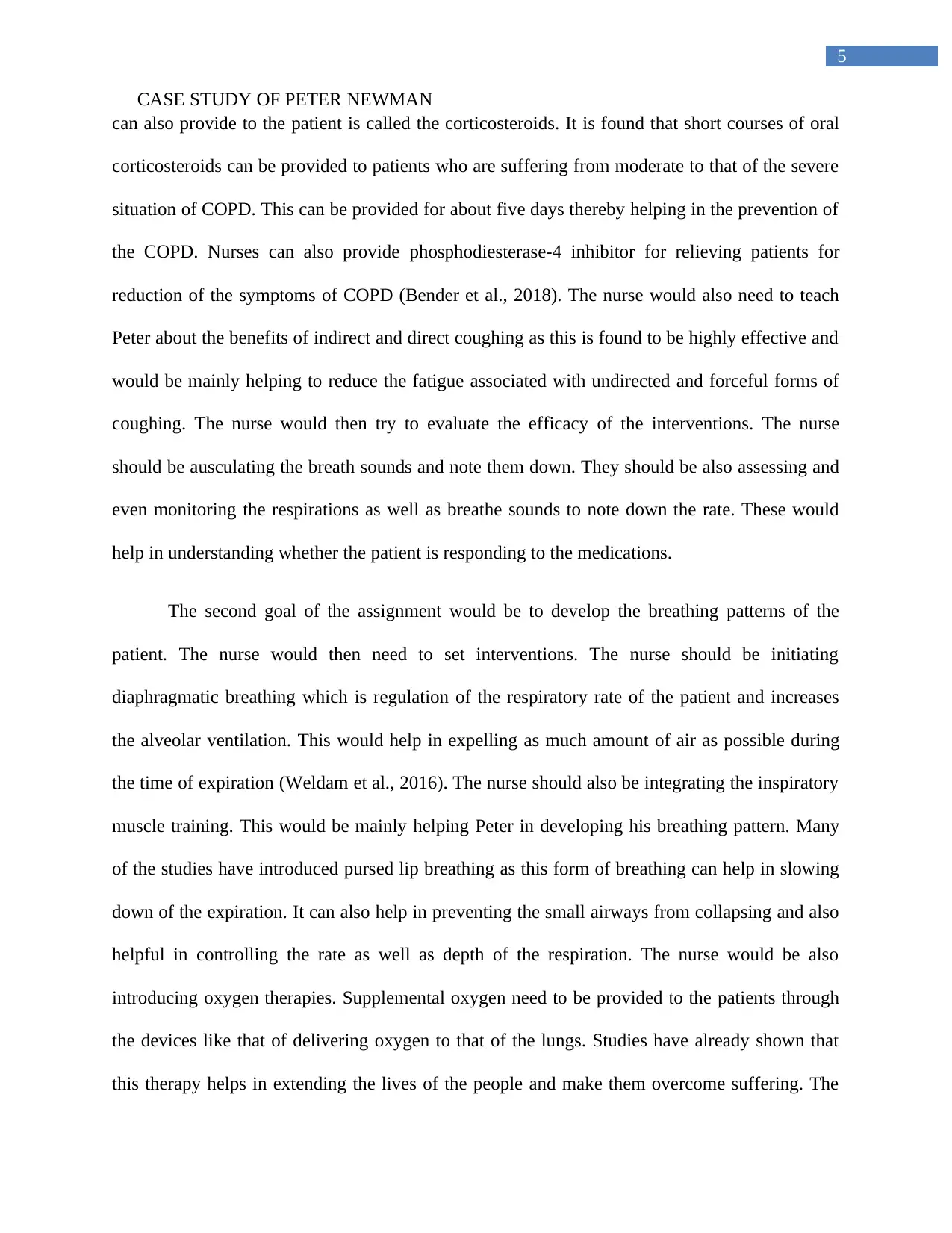
5
CASE STUDY OF PETER NEWMAN
can also provide to the patient is called the corticosteroids. It is found that short courses of oral
corticosteroids can be provided to patients who are suffering from moderate to that of the severe
situation of COPD. This can be provided for about five days thereby helping in the prevention of
the COPD. Nurses can also provide phosphodiesterase-4 inhibitor for relieving patients for
reduction of the symptoms of COPD (Bender et al., 2018). The nurse would also need to teach
Peter about the benefits of indirect and direct coughing as this is found to be highly effective and
would be mainly helping to reduce the fatigue associated with undirected and forceful forms of
coughing. The nurse would then try to evaluate the efficacy of the interventions. The nurse
should be ausculating the breath sounds and note them down. They should be also assessing and
even monitoring the respirations as well as breathe sounds to note down the rate. These would
help in understanding whether the patient is responding to the medications.
The second goal of the assignment would be to develop the breathing patterns of the
patient. The nurse would then need to set interventions. The nurse should be initiating
diaphragmatic breathing which is regulation of the respiratory rate of the patient and increases
the alveolar ventilation. This would help in expelling as much amount of air as possible during
the time of expiration (Weldam et al., 2016). The nurse should also be integrating the inspiratory
muscle training. This would be mainly helping Peter in developing his breathing pattern. Many
of the studies have introduced pursed lip breathing as this form of breathing can help in slowing
down of the expiration. It can also help in preventing the small airways from collapsing and also
helpful in controlling the rate as well as depth of the respiration. The nurse would be also
introducing oxygen therapies. Supplemental oxygen need to be provided to the patients through
the devices like that of delivering oxygen to that of the lungs. Studies have already shown that
this therapy helps in extending the lives of the people and make them overcome suffering. The
CASE STUDY OF PETER NEWMAN
can also provide to the patient is called the corticosteroids. It is found that short courses of oral
corticosteroids can be provided to patients who are suffering from moderate to that of the severe
situation of COPD. This can be provided for about five days thereby helping in the prevention of
the COPD. Nurses can also provide phosphodiesterase-4 inhibitor for relieving patients for
reduction of the symptoms of COPD (Bender et al., 2018). The nurse would also need to teach
Peter about the benefits of indirect and direct coughing as this is found to be highly effective and
would be mainly helping to reduce the fatigue associated with undirected and forceful forms of
coughing. The nurse would then try to evaluate the efficacy of the interventions. The nurse
should be ausculating the breath sounds and note them down. They should be also assessing and
even monitoring the respirations as well as breathe sounds to note down the rate. These would
help in understanding whether the patient is responding to the medications.
The second goal of the assignment would be to develop the breathing patterns of the
patient. The nurse would then need to set interventions. The nurse should be initiating
diaphragmatic breathing which is regulation of the respiratory rate of the patient and increases
the alveolar ventilation. This would help in expelling as much amount of air as possible during
the time of expiration (Weldam et al., 2016). The nurse should also be integrating the inspiratory
muscle training. This would be mainly helping Peter in developing his breathing pattern. Many
of the studies have introduced pursed lip breathing as this form of breathing can help in slowing
down of the expiration. It can also help in preventing the small airways from collapsing and also
helpful in controlling the rate as well as depth of the respiration. The nurse would be also
introducing oxygen therapies. Supplemental oxygen need to be provided to the patients through
the devices like that of delivering oxygen to that of the lungs. Studies have already shown that
this therapy helps in extending the lives of the people and make them overcome suffering. The
⊘ This is a preview!⊘
Do you want full access?
Subscribe today to unlock all pages.

Trusted by 1+ million students worldwide
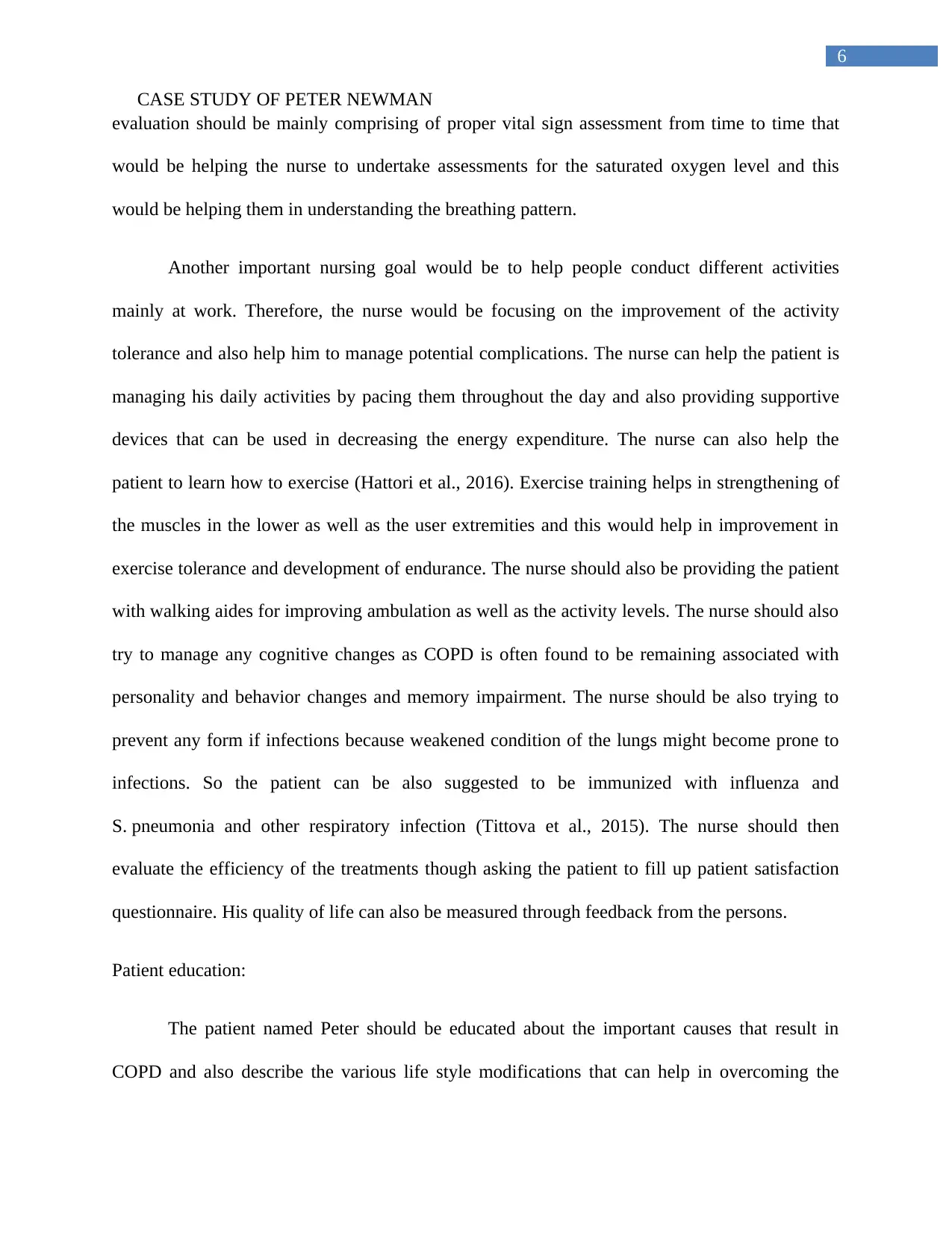
6
CASE STUDY OF PETER NEWMAN
evaluation should be mainly comprising of proper vital sign assessment from time to time that
would be helping the nurse to undertake assessments for the saturated oxygen level and this
would be helping them in understanding the breathing pattern.
Another important nursing goal would be to help people conduct different activities
mainly at work. Therefore, the nurse would be focusing on the improvement of the activity
tolerance and also help him to manage potential complications. The nurse can help the patient is
managing his daily activities by pacing them throughout the day and also providing supportive
devices that can be used in decreasing the energy expenditure. The nurse can also help the
patient to learn how to exercise (Hattori et al., 2016). Exercise training helps in strengthening of
the muscles in the lower as well as the user extremities and this would help in improvement in
exercise tolerance and development of endurance. The nurse should also be providing the patient
with walking aides for improving ambulation as well as the activity levels. The nurse should also
try to manage any cognitive changes as COPD is often found to be remaining associated with
personality and behavior changes and memory impairment. The nurse should be also trying to
prevent any form if infections because weakened condition of the lungs might become prone to
infections. So the patient can be also suggested to be immunized with influenza and
S. pneumonia and other respiratory infection (Tittova et al., 2015). The nurse should then
evaluate the efficiency of the treatments though asking the patient to fill up patient satisfaction
questionnaire. His quality of life can also be measured through feedback from the persons.
Patient education:
The patient named Peter should be educated about the important causes that result in
COPD and also describe the various life style modifications that can help in overcoming the
CASE STUDY OF PETER NEWMAN
evaluation should be mainly comprising of proper vital sign assessment from time to time that
would be helping the nurse to undertake assessments for the saturated oxygen level and this
would be helping them in understanding the breathing pattern.
Another important nursing goal would be to help people conduct different activities
mainly at work. Therefore, the nurse would be focusing on the improvement of the activity
tolerance and also help him to manage potential complications. The nurse can help the patient is
managing his daily activities by pacing them throughout the day and also providing supportive
devices that can be used in decreasing the energy expenditure. The nurse can also help the
patient to learn how to exercise (Hattori et al., 2016). Exercise training helps in strengthening of
the muscles in the lower as well as the user extremities and this would help in improvement in
exercise tolerance and development of endurance. The nurse should also be providing the patient
with walking aides for improving ambulation as well as the activity levels. The nurse should also
try to manage any cognitive changes as COPD is often found to be remaining associated with
personality and behavior changes and memory impairment. The nurse should be also trying to
prevent any form if infections because weakened condition of the lungs might become prone to
infections. So the patient can be also suggested to be immunized with influenza and
S. pneumonia and other respiratory infection (Tittova et al., 2015). The nurse should then
evaluate the efficiency of the treatments though asking the patient to fill up patient satisfaction
questionnaire. His quality of life can also be measured through feedback from the persons.
Patient education:
The patient named Peter should be educated about the important causes that result in
COPD and also describe the various life style modifications that can help in overcoming the
Paraphrase This Document
Need a fresh take? Get an instant paraphrase of this document with our AI Paraphraser
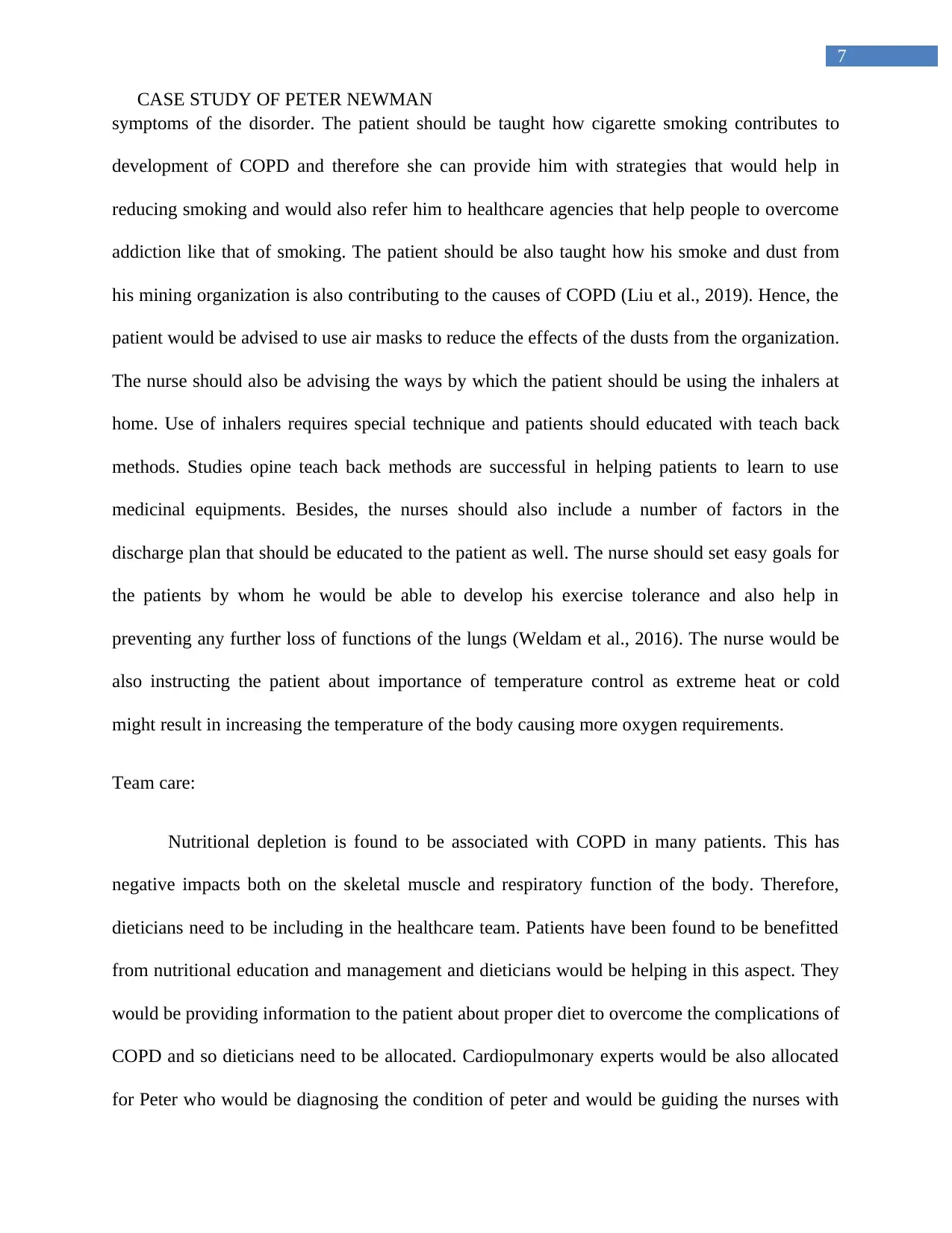
7
CASE STUDY OF PETER NEWMAN
symptoms of the disorder. The patient should be taught how cigarette smoking contributes to
development of COPD and therefore she can provide him with strategies that would help in
reducing smoking and would also refer him to healthcare agencies that help people to overcome
addiction like that of smoking. The patient should be also taught how his smoke and dust from
his mining organization is also contributing to the causes of COPD (Liu et al., 2019). Hence, the
patient would be advised to use air masks to reduce the effects of the dusts from the organization.
The nurse should also be advising the ways by which the patient should be using the inhalers at
home. Use of inhalers requires special technique and patients should educated with teach back
methods. Studies opine teach back methods are successful in helping patients to learn to use
medicinal equipments. Besides, the nurses should also include a number of factors in the
discharge plan that should be educated to the patient as well. The nurse should set easy goals for
the patients by whom he would be able to develop his exercise tolerance and also help in
preventing any further loss of functions of the lungs (Weldam et al., 2016). The nurse would be
also instructing the patient about importance of temperature control as extreme heat or cold
might result in increasing the temperature of the body causing more oxygen requirements.
Team care:
Nutritional depletion is found to be associated with COPD in many patients. This has
negative impacts both on the skeletal muscle and respiratory function of the body. Therefore,
dieticians need to be including in the healthcare team. Patients have been found to be benefitted
from nutritional education and management and dieticians would be helping in this aspect. They
would be providing information to the patient about proper diet to overcome the complications of
COPD and so dieticians need to be allocated. Cardiopulmonary experts would be also allocated
for Peter who would be diagnosing the condition of peter and would be guiding the nurses with
CASE STUDY OF PETER NEWMAN
symptoms of the disorder. The patient should be taught how cigarette smoking contributes to
development of COPD and therefore she can provide him with strategies that would help in
reducing smoking and would also refer him to healthcare agencies that help people to overcome
addiction like that of smoking. The patient should be also taught how his smoke and dust from
his mining organization is also contributing to the causes of COPD (Liu et al., 2019). Hence, the
patient would be advised to use air masks to reduce the effects of the dusts from the organization.
The nurse should also be advising the ways by which the patient should be using the inhalers at
home. Use of inhalers requires special technique and patients should educated with teach back
methods. Studies opine teach back methods are successful in helping patients to learn to use
medicinal equipments. Besides, the nurses should also include a number of factors in the
discharge plan that should be educated to the patient as well. The nurse should set easy goals for
the patients by whom he would be able to develop his exercise tolerance and also help in
preventing any further loss of functions of the lungs (Weldam et al., 2016). The nurse would be
also instructing the patient about importance of temperature control as extreme heat or cold
might result in increasing the temperature of the body causing more oxygen requirements.
Team care:
Nutritional depletion is found to be associated with COPD in many patients. This has
negative impacts both on the skeletal muscle and respiratory function of the body. Therefore,
dieticians need to be including in the healthcare team. Patients have been found to be benefitted
from nutritional education and management and dieticians would be helping in this aspect. They
would be providing information to the patient about proper diet to overcome the complications of
COPD and so dieticians need to be allocated. Cardiopulmonary experts would be also allocated
for Peter who would be diagnosing the condition of peter and would be guiding the nurses with
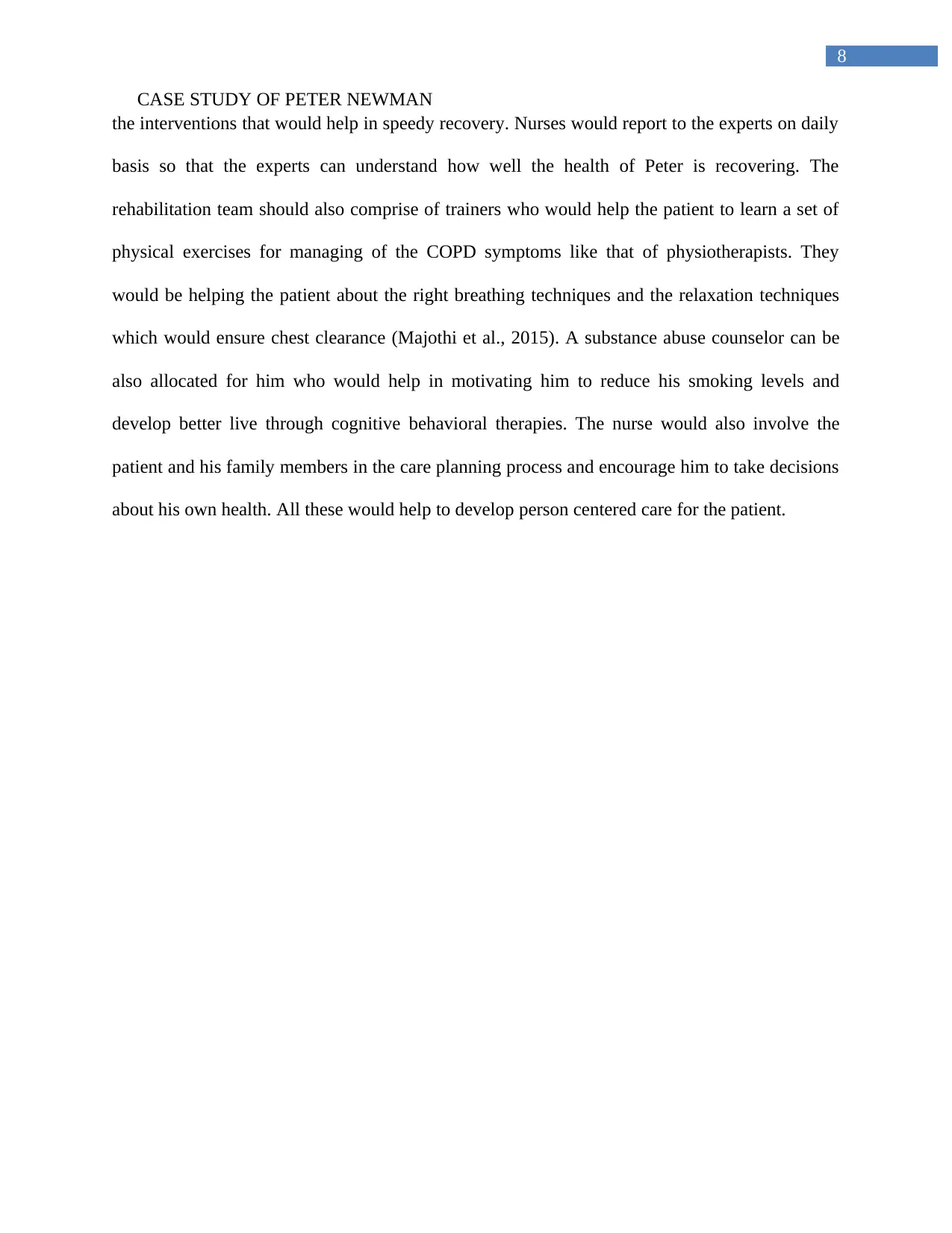
8
CASE STUDY OF PETER NEWMAN
the interventions that would help in speedy recovery. Nurses would report to the experts on daily
basis so that the experts can understand how well the health of Peter is recovering. The
rehabilitation team should also comprise of trainers who would help the patient to learn a set of
physical exercises for managing of the COPD symptoms like that of physiotherapists. They
would be helping the patient about the right breathing techniques and the relaxation techniques
which would ensure chest clearance (Majothi et al., 2015). A substance abuse counselor can be
also allocated for him who would help in motivating him to reduce his smoking levels and
develop better live through cognitive behavioral therapies. The nurse would also involve the
patient and his family members in the care planning process and encourage him to take decisions
about his own health. All these would help to develop person centered care for the patient.
CASE STUDY OF PETER NEWMAN
the interventions that would help in speedy recovery. Nurses would report to the experts on daily
basis so that the experts can understand how well the health of Peter is recovering. The
rehabilitation team should also comprise of trainers who would help the patient to learn a set of
physical exercises for managing of the COPD symptoms like that of physiotherapists. They
would be helping the patient about the right breathing techniques and the relaxation techniques
which would ensure chest clearance (Majothi et al., 2015). A substance abuse counselor can be
also allocated for him who would help in motivating him to reduce his smoking levels and
develop better live through cognitive behavioral therapies. The nurse would also involve the
patient and his family members in the care planning process and encourage him to take decisions
about his own health. All these would help to develop person centered care for the patient.
⊘ This is a preview!⊘
Do you want full access?
Subscribe today to unlock all pages.

Trusted by 1+ million students worldwide

9
CASE STUDY OF PETER NEWMAN
References:
Baker, E., & Fatoye, F. (2017). Clinical and cost effectiveness of nurse-led self-management
interventions for patients with copd in primary care: A systematic review. International
journal of nursing studies, 71, 125-138. https://doi.org/10.1016/j.ijnurstu.2017.03.010
Baker, E., & Fatoye, F. (2018). Patient perceived impact of nurse-led self-management
interventions for COPD: A systematic review of qualitative research. International
journal of nursing studies. https://doi.org/10.1016/j.ijnurstu.2018.12.004
Bender, M. S., Janson, S. L., Franck, L. S., & Lee, K. A. (2018). Theory of Symptom
Management. Middle Range Theory for Nursing, 2017147.
https://books.google.co.in/books?
hl=en&lr=&id=XN1JDwAAQBAJ&oi=fnd&pg=PA147&dq=COPD+nursing+managem
ent&ots=hd8-ImsUsB&sig=X0kixwzCnZxb_1dVYION2-XtiUc#v=onepage&q=COPD
%20nursing%20management&f=false
Bourbeau, J., Casan, P., Tognella, S., Haidl, P., Texereau, J. B., & Kessler, R. (2016). An
international randomized study of a home-based self-management program for severe
COPD: the COMET. International journal of chronic obstructive pulmonary disease, 11,
1447. doi: 10.2147/COPD.S107151
CASE STUDY OF PETER NEWMAN
References:
Baker, E., & Fatoye, F. (2017). Clinical and cost effectiveness of nurse-led self-management
interventions for patients with copd in primary care: A systematic review. International
journal of nursing studies, 71, 125-138. https://doi.org/10.1016/j.ijnurstu.2017.03.010
Baker, E., & Fatoye, F. (2018). Patient perceived impact of nurse-led self-management
interventions for COPD: A systematic review of qualitative research. International
journal of nursing studies. https://doi.org/10.1016/j.ijnurstu.2018.12.004
Bender, M. S., Janson, S. L., Franck, L. S., & Lee, K. A. (2018). Theory of Symptom
Management. Middle Range Theory for Nursing, 2017147.
https://books.google.co.in/books?
hl=en&lr=&id=XN1JDwAAQBAJ&oi=fnd&pg=PA147&dq=COPD+nursing+managem
ent&ots=hd8-ImsUsB&sig=X0kixwzCnZxb_1dVYION2-XtiUc#v=onepage&q=COPD
%20nursing%20management&f=false
Bourbeau, J., Casan, P., Tognella, S., Haidl, P., Texereau, J. B., & Kessler, R. (2016). An
international randomized study of a home-based self-management program for severe
COPD: the COMET. International journal of chronic obstructive pulmonary disease, 11,
1447. doi: 10.2147/COPD.S107151
Paraphrase This Document
Need a fresh take? Get an instant paraphrase of this document with our AI Paraphraser
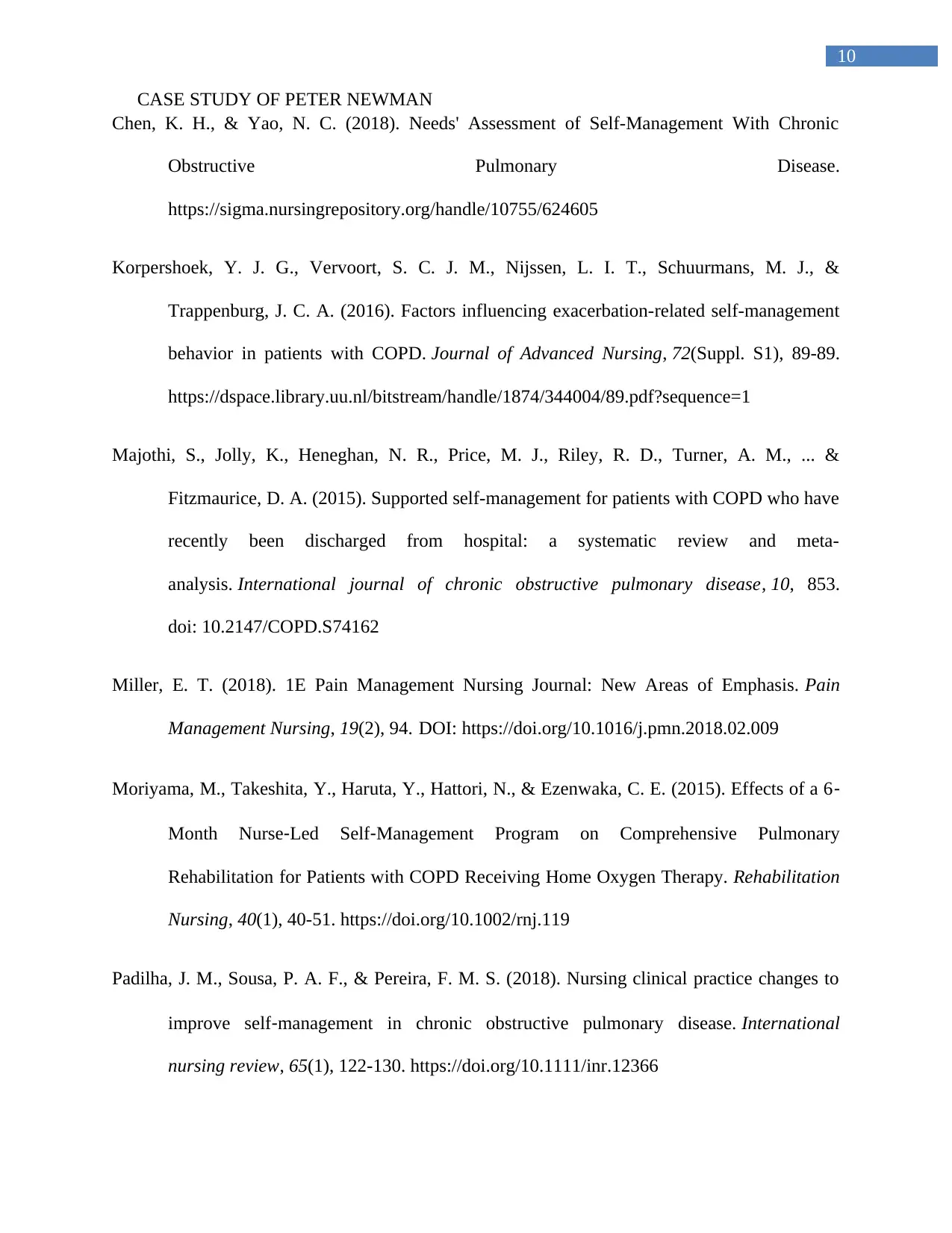
10
CASE STUDY OF PETER NEWMAN
Chen, K. H., & Yao, N. C. (2018). Needs' Assessment of Self-Management With Chronic
Obstructive Pulmonary Disease.
https://sigma.nursingrepository.org/handle/10755/624605
Korpershoek, Y. J. G., Vervoort, S. C. J. M., Nijssen, L. I. T., Schuurmans, M. J., &
Trappenburg, J. C. A. (2016). Factors influencing exacerbation-related self-management
behavior in patients with COPD. Journal of Advanced Nursing, 72(Suppl. S1), 89-89.
https://dspace.library.uu.nl/bitstream/handle/1874/344004/89.pdf?sequence=1
Majothi, S., Jolly, K., Heneghan, N. R., Price, M. J., Riley, R. D., Turner, A. M., ... &
Fitzmaurice, D. A. (2015). Supported self-management for patients with COPD who have
recently been discharged from hospital: a systematic review and meta-
analysis. International journal of chronic obstructive pulmonary disease, 10, 853.
doi: 10.2147/COPD.S74162
Miller, E. T. (2018). 1E Pain Management Nursing Journal: New Areas of Emphasis. Pain
Management Nursing, 19(2), 94. DOI: https://doi.org/10.1016/j.pmn.2018.02.009
Moriyama, M., Takeshita, Y., Haruta, Y., Hattori, N., & Ezenwaka, C. E. (2015). Effects of a 6‐
Month Nurse‐Led Self‐Management Program on Comprehensive Pulmonary
Rehabilitation for Patients with COPD Receiving Home Oxygen Therapy. Rehabilitation
Nursing, 40(1), 40-51. https://doi.org/10.1002/rnj.119
Padilha, J. M., Sousa, P. A. F., & Pereira, F. M. S. (2018). Nursing clinical practice changes to
improve self‐management in chronic obstructive pulmonary disease. International
nursing review, 65(1), 122-130. https://doi.org/10.1111/inr.12366
CASE STUDY OF PETER NEWMAN
Chen, K. H., & Yao, N. C. (2018). Needs' Assessment of Self-Management With Chronic
Obstructive Pulmonary Disease.
https://sigma.nursingrepository.org/handle/10755/624605
Korpershoek, Y. J. G., Vervoort, S. C. J. M., Nijssen, L. I. T., Schuurmans, M. J., &
Trappenburg, J. C. A. (2016). Factors influencing exacerbation-related self-management
behavior in patients with COPD. Journal of Advanced Nursing, 72(Suppl. S1), 89-89.
https://dspace.library.uu.nl/bitstream/handle/1874/344004/89.pdf?sequence=1
Majothi, S., Jolly, K., Heneghan, N. R., Price, M. J., Riley, R. D., Turner, A. M., ... &
Fitzmaurice, D. A. (2015). Supported self-management for patients with COPD who have
recently been discharged from hospital: a systematic review and meta-
analysis. International journal of chronic obstructive pulmonary disease, 10, 853.
doi: 10.2147/COPD.S74162
Miller, E. T. (2018). 1E Pain Management Nursing Journal: New Areas of Emphasis. Pain
Management Nursing, 19(2), 94. DOI: https://doi.org/10.1016/j.pmn.2018.02.009
Moriyama, M., Takeshita, Y., Haruta, Y., Hattori, N., & Ezenwaka, C. E. (2015). Effects of a 6‐
Month Nurse‐Led Self‐Management Program on Comprehensive Pulmonary
Rehabilitation for Patients with COPD Receiving Home Oxygen Therapy. Rehabilitation
Nursing, 40(1), 40-51. https://doi.org/10.1002/rnj.119
Padilha, J. M., Sousa, P. A. F., & Pereira, F. M. S. (2018). Nursing clinical practice changes to
improve self‐management in chronic obstructive pulmonary disease. International
nursing review, 65(1), 122-130. https://doi.org/10.1111/inr.12366
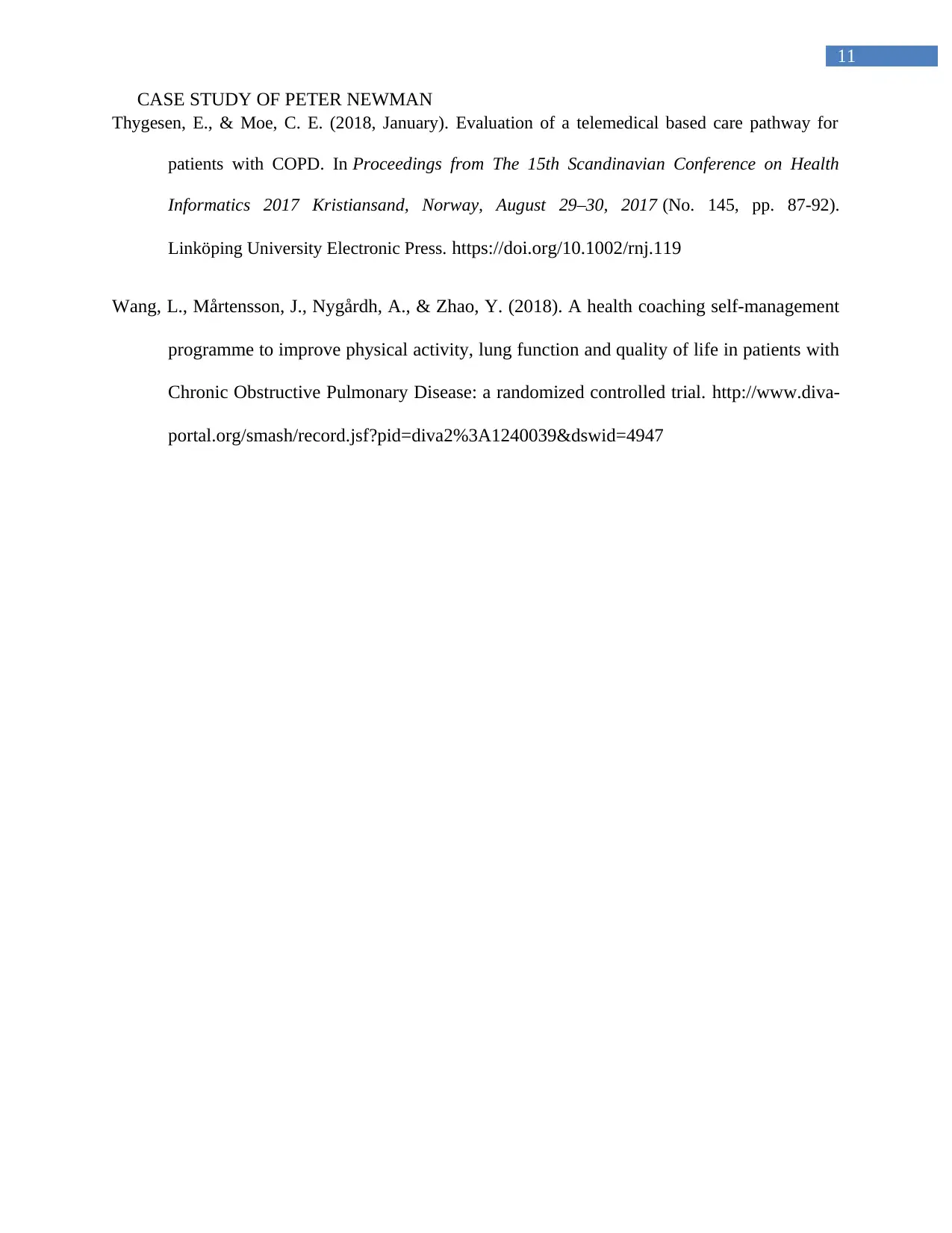
11
CASE STUDY OF PETER NEWMAN
Thygesen, E., & Moe, C. E. (2018, January). Evaluation of a telemedical based care pathway for
patients with COPD. In Proceedings from The 15th Scandinavian Conference on Health
Informatics 2017 Kristiansand, Norway, August 29–30, 2017 (No. 145, pp. 87-92).
Linköping University Electronic Press. https://doi.org/10.1002/rnj.119
Wang, L., Mårtensson, J., Nygårdh, A., & Zhao, Y. (2018). A health coaching self-management
programme to improve physical activity, lung function and quality of life in patients with
Chronic Obstructive Pulmonary Disease: a randomized controlled trial. http://www.diva-
portal.org/smash/record.jsf?pid=diva2%3A1240039&dswid=4947
CASE STUDY OF PETER NEWMAN
Thygesen, E., & Moe, C. E. (2018, January). Evaluation of a telemedical based care pathway for
patients with COPD. In Proceedings from The 15th Scandinavian Conference on Health
Informatics 2017 Kristiansand, Norway, August 29–30, 2017 (No. 145, pp. 87-92).
Linköping University Electronic Press. https://doi.org/10.1002/rnj.119
Wang, L., Mårtensson, J., Nygårdh, A., & Zhao, Y. (2018). A health coaching self-management
programme to improve physical activity, lung function and quality of life in patients with
Chronic Obstructive Pulmonary Disease: a randomized controlled trial. http://www.diva-
portal.org/smash/record.jsf?pid=diva2%3A1240039&dswid=4947
⊘ This is a preview!⊘
Do you want full access?
Subscribe today to unlock all pages.

Trusted by 1+ million students worldwide
1 out of 12
Related Documents
Your All-in-One AI-Powered Toolkit for Academic Success.
+13062052269
info@desklib.com
Available 24*7 on WhatsApp / Email
![[object Object]](/_next/static/media/star-bottom.7253800d.svg)
Unlock your academic potential
Copyright © 2020–2025 A2Z Services. All Rights Reserved. Developed and managed by ZUCOL.





